#rayon fabric vs cotton
Text
Explore the enchanting world of rayon fabrics and discover its fascinating history, versatile applications, and myriad benefits. Read our informative blog today!
#rayon fabrics#viscose#rayoncrepe#rayon fabric for kurti#unstitched rayon fabric#rayon cotton fabric#rayon fabric clothes#rayon fabric examples#rayon fabric synthetic#rayon fabric vs cotton#viscose rayon fabric#rayon material#rayon cloth#rayon slub fabric#polyester rayon fabric#rayon fabric good for summer#viscose clothing#rayon dress material online#rayon in summer
0 notes
Text
! crossposting from my twitter !
bucktommy costume analysis 👔
hi ! i'm a fashion student and am really interested in costume design so i wanted to do a (long) post on tommy's style and how i think buck might be influenced by it in s8 as seen in "buck's britches." :))
[about tommy]
tommy's wardrobe is entirely functional and indicative of his dedication to his work. it's practical, useful, and speaks of his can-do attitude.
all his signature clothes (henleys, shackets, canvas jackets) have historical traces to being used as workwear.
(1) henleys - this one, ironically in the philippines it has its own term in our local language. it's called a camisa de chino and is used by laborers. although i live in a different country, i'm sure its use case is still the same for other countries as it's historically deemed the workman's undergarment.
also: yes. tommy is technically right. there were henleys in the 80s. even in the 1880s. so what we're learning here now folks, is that he's a smartass little shit.
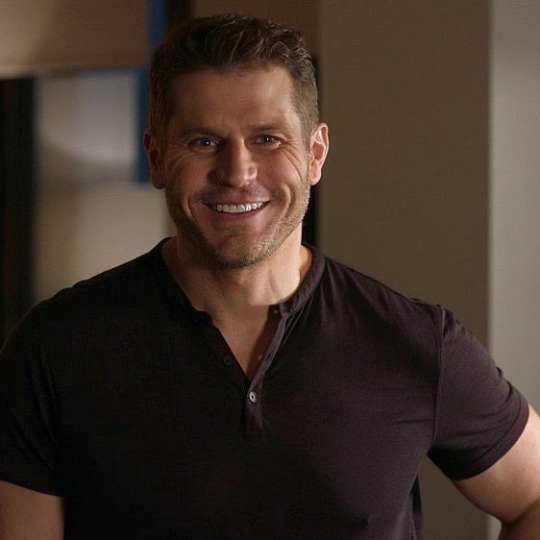


(2) shackets - historically, also an item used by the working class. they were mostly worn to prevent any possible stains on inner clothes from their work (i.e. dirt, grease, grime, etc.)
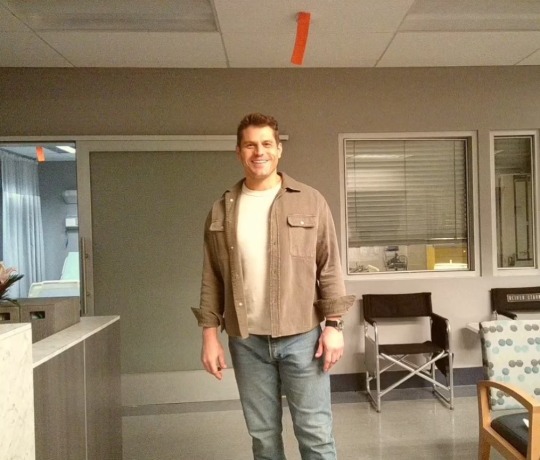

(3) canvas jacket - although this was only seen in 7x04, it's more likely that he still owns a lot more. (waxed) canvas jackets are traditional workwear often used as weatherproof outerwear or heavy duty rainwear.
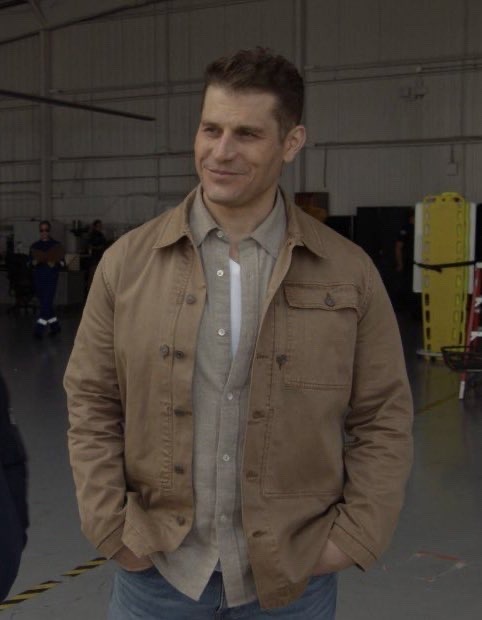
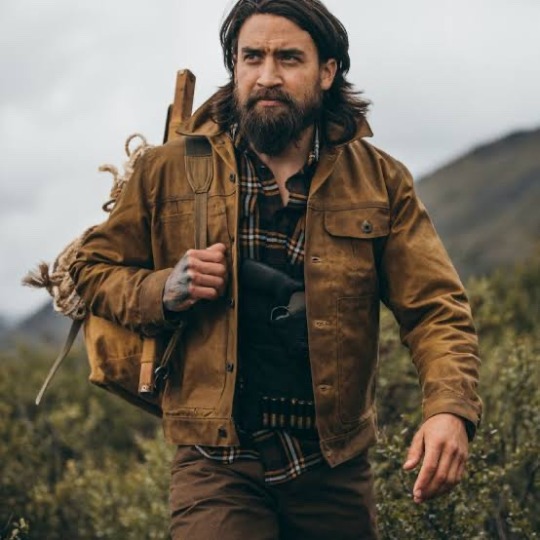
as a form of fun speculation, i'd like to think some of these items are also in his closet:
contrast collar canvas jacket
an authentic flight jacket
overalls, but only for when he fixes up the car
denim trucker jacket
if anything, who better to listen to when talking about tommy's clothes than tommy himself !
here's lou's cameo for me describing tommy's closet as rugged, practical and useful :))
[about "buck's britches"]
now to the "buck's britches" post. two notable items of clothing:
the famous flight jacket
baker pants.

now here's the thing about buck:
buck doesn't wear utilitarian clothing. in fact, he doesn't wear woven clothing all that much. he wears knit. knit polos. sweaters. hoodies. he is not a workwear person. in fact: he's a comfort person.
that's his primary reason for style that's a testament to his own character. buck is widely recognized as the more radiant and funny character. he has charisma and is very inviting, which is accompanied by his choice in clothing.
soft, warm, comfortable.

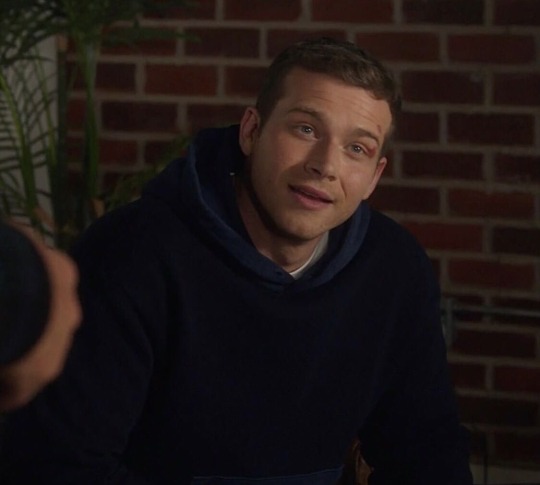
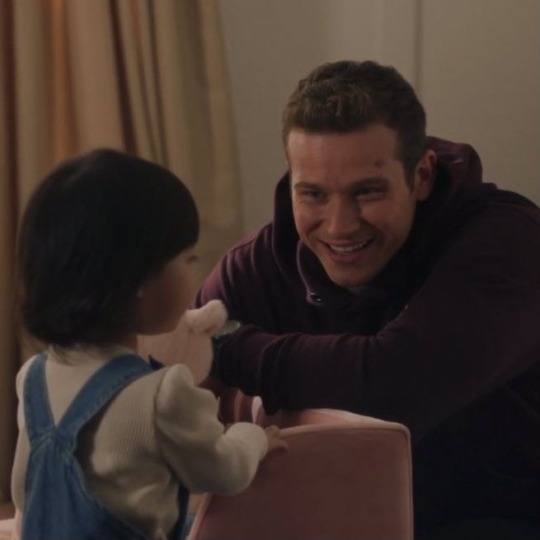

which goes back to the photo ostark posted on his instagram story.
(1) flight jacket - here's where i have to go and burst everyone's bubble for a bit. this is only a flight jacket because it's labelled as such. but categorically, it isn't. flight jackets are the classic term for bomber jackets.
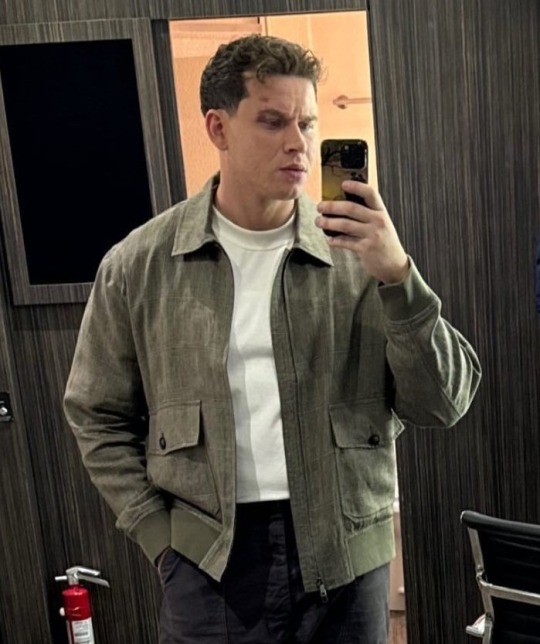
bomber jackets (and flight jackets) were workwear used by the military, characterized by garterized cuffs and hems and short bodices. for pilots, they were interchangeable. but modernly, they have some more definable features.
characteristically, flight (or aviator) jackets are leather with shearling or sherpa collars. bomber jackets are the modernized version taking the silhouette and cuff designs and making them more accessible through material choice (linen—like buck—nylon, silk)


(2) baker pants - as the name suggests, it's a piece of kitchen workwear often in twill (which i'd assume is what oliver is wearing), denim, cotton or linen. it's characterized by the topstitching to outline the pockets and diagonal pocket openings (vs. the usual curve).
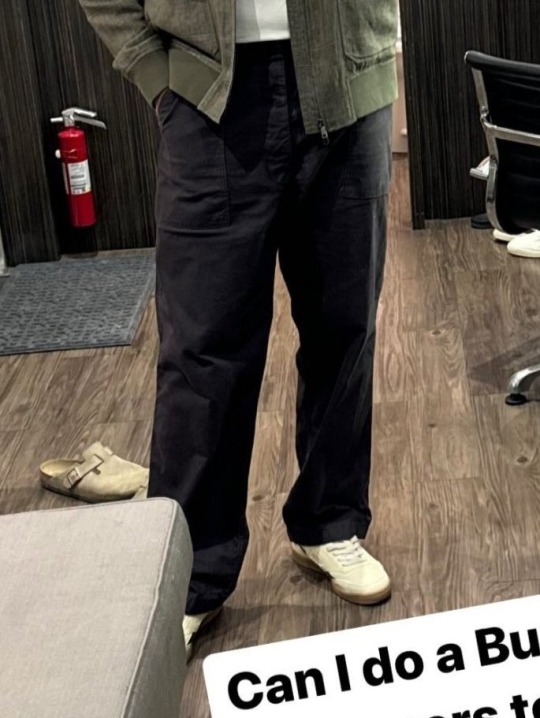
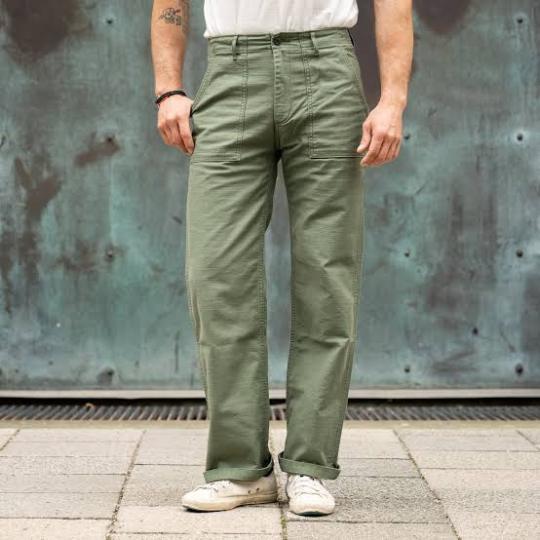
so very evidently: buck has been influenced by tommy's style. he's wearing woven material versus knit for one. if i were hopeful, i'd say they're exploring one another's style because they're sharing a closet.
[character analysis]
woven fabric as a material is sturdy. it's more structured and does not stretch. think: cotton, linen, rayon, wool, denim. what this means for buck is that, by virtue of being tommy's boyfriend he is introduced to structure, groundedness and maturity.
tommy's closet is filled with utilitarian clothing and workwear. he, as a character, is known to be emotionally grounded and mature and it translates to his clothing.
buck adapting the defining features of his wardrobe shows how much tommy has helped him get off his hamster wheel.
in fact, even the inverse can be noted. when buck asks for a second chance and practices communication towards tommy. he's wearing a woven buttondown. and in emphasizing tommy's desire to make buck comfortable, he's in a hoodie. neither of which are common for one another.

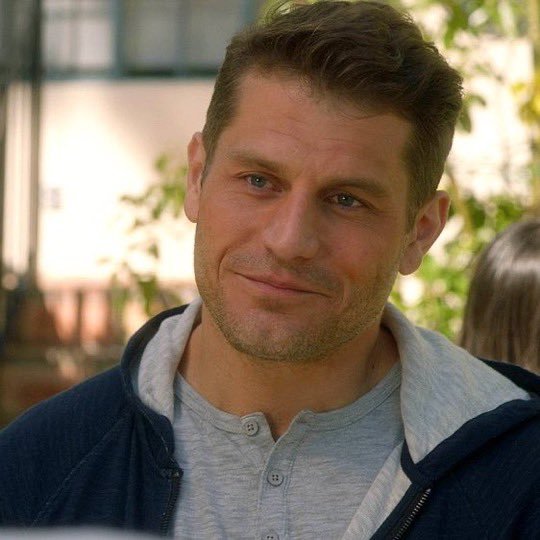
buck and tommy, even through subtle clothing choices are becoming part of one another's world and that makes me so soft as someone whose love language is fashion.


[wishful thinking]
perhaps maybe we could see tommy in a fully casual sweat set? i know that they might be protecting lfjr but man. if i see a hoodie on him. (nqueso, if you can sneak me a photo of him in knitwear ill love you forever i just want to prove my theory right i wont even post it)
if they are putting buck in this sort of attire, my guess (or hope) is that they have tommy ease up too.
it would be nice to show buck's effect on tommy as much as tommy's effect on buck because tommy's an established character and has a backstory that the writers could explore.
so if the 9-1-1 costume designers ever see this:
please put tommy in a sweat set. or a hoodie. (not a zip-up one, im talking real hoodie). i'm willing to compromise with overalls. i see what you're doing with buck's wardrobe, and love it. maybe tommy's could soften up too :))
thanks for reading ! 🫶

#911 on abc#tommy kinard#bucktommy#evan buckley#tevan#911 abc#lou ferrigno jr#bi buck#911#costume#costume design#analysis#sorry its a long post im just sort of obsessed with the idea of them sharing closets#my beloved#i love fashion#costume design analysis#contemporary costuming
350 notes
·
View notes
Note
As someone who can't wear fabrics that are itchy, (rough) even if it washed in softener. Can you give advice on what to look for? I need more business clothes but it seems all the work pants I find for the office is made of that fabric.
Oh this is a tough one. Unfortunately, you might have to go for a higher price point. A fix that worked for an actress I used to work with was wearing satiny cuddl duds in the winter and tights in the summer under all of her pants but YMMV.
(this next part assumes you're US American but I think the idea is applicable everywhere)
First, I would recommend going a slightly fancy department store like Nordstroms. You don't have to buy anything, just feel some clothing to figure out what fabrics you like and write it down. I would recommend going to a higher end store vs like JC Pennys because manufactures like to lie about fabric content and in my personal experience it's less of an issue if you go to a more expensive store. If you're like me, anything rayon, wool, or polyester is a no-go. Semi synthetic fabrics are hit or miss. I'm personally good with silks, satins, linens, and cottons. (If you're not allergic to wool, apparently merino wool is great)
If you're close to a bigger city, you'll probably be good to shop in store. Smaller towns you'll probably have to do online shoping in order to avoid certain fabrics. I haven't shopped at all these but off the top of my head some good stores to check out might be: Quince, Universal Standard, Good American, Amour Vet, Madewell, and Macy's but be real vigilant about checking the fabric content. Rich People Goodwill can have some great stuff but with the rise of thrifting it can be a slog (and real frustrating depending on your size)
May the odds be in your favor on the hunt for non scratchy clothes <3
79 notes
·
View notes
Text
For the writers who think textiles are overwhelming and difficult to understand (this is objectively correct), but still want to get character descriptions right, I have just the thing!!!
This [link BROKEN, it originally went to fabric for cosplayers .com] is my absolute favourite resource for researching fabrics. It’s written for cosplayers so it has very straightforward descriptions of weaves, compositions, properties, etc!!! And it includes historical and luxury fabrics! Depending on the article, there’s mentions of price, rarity, historical significance, and it prioritizes the perspective of the wearer. I use it for initial research, and I highly recommend it for quick overviews and factchecking. [looking for alternatives]
If you’re looking for a more detailed look at specific fabric composition, I *highly* recommend Nicole Rudolph’s playlist “Sewing 101”. It’s a deep dive that will absolutely sort out simple errors like satin vs silk, it covers the mainstream natural fibers from a Western historical costuming lens: cotton, silk, linen, and wool, with mentions of rayon. Also, the other videos in the playlist are great if you have, say, a fantasy assassin working undercover as a dressmaker or tailor in a 19th century AU.
EDIT: fabric for cosplayers is down. I don’t know of any equivalent websites, but I’ll be on the lookout. This is really a devastating loss.
12 notes
·
View notes
Text
It's suddenly very important that I estimate the price tags and availability of every possible fabric commonly available to normal middle-class Londoners in the Neath vs Albion. We are going to rank these based on cost and likelihood of availability.
10/10 availability means it's easy to produce, distribute, and useful. 10/10 price means it's expensive.
-=-
LINEN: Antibacterial, breathable, durable, dries quickly. However, has a lengthy drying, curing process along with separating it from the flax fiber. Linen grows in wet, windy climates and needs water for processing.
Could probably be grown in the Neath with appropriate lighting installed(?) Likely has a high cost to export to the skies (if trade route exists). Could maybe be grown in the Reach?? Would require space and appropriate conditions.
Rating: 5/10 . Price: 4/10
.
COTTON: Increasing prevalence due to the cheapness for nasty colonial reasons. However, requires extensive space and water to grow, along with a hot, humid climate. The textile itself is slow to dry and prone to mildew.
Requires a hot climate and plenty of water. I vote only the surface could produce it, and then, only Skies inhabitants would wear it because it's incompatible with the Neath.
Rating: 2/10 . Price: 10/10 after all the taxes.
.
WOOL: Normal textile. Renewable, breathable, odor resistant.
Available: Wherever sheep, goats, rabbits, alpacas, etc. can be bred.
Goats will eat anything man. Some wool animals do not necessarily require light, and can be bred over time for low light levels. Friendship work pets! Would thrive alright in the Reach and they're already on Shepherd's Isles if I remember right. I assume wool would be cheap after extensive cultivation.
Rating: 10/10 . Price: 2/10
.
MUSHROOMS: I'm just researching this. Apparently it's a new, sustainable fabric people are exploring; mushroom textiles/mycelium is bacteria-resistant and breathable. However, I think the mycelium is literally grown to fit your body...? It seems like the company's selling point is the decrease in time from not sewing the object. (If I'm reading the website correctly.) This seems stupid honestly. You can already make plywood from mushrooms with some processing since the stems have cellulose similar to wood. Just treat it like you do bamboo textiles/rayon. I could be reading the articles wrong.
Mushroom fabric could be available both in the Neath and the Skies. Processing necessary unless you're doing it the stupid way, which you know what, I bet some rich fucker does want a one-piece mushroom suit grown to their body.
Rating: 4/10 . Price: 5/10 ... (One-piece: Rating: 1/10 . Price: 8/10)
.
(Leather under the cut. Not a huge fan but realized it would also be available and was important at the time. Plus, I stumbled onto the development of chromium tanning in the 1850s so if anyone is interested there's a brief write-up on that. However, don't read otherwise. Wool is hands-down the best textile resource available. Leather is a 2/10 . 2/10.)
LEATHER: Leather requires processing since you have to remove water molecules from the collagen (proteins) of the skin. Only removing the water from the skin makes it dry and stiff, but if you soak the skin in tannin to replace the water molecules instead of just removing them, you can prevent the stiffening.
Tanning usually took 1-2 months until 1858 when chromium salts were found to also replace collagen. Chromium tanning only takes one or two days, but causes massive environmental and physical damage due to chromium being a respiratory tract irritant and carcinogenic. Vegetable tannins are frequently used now, but chromium tanning still makes up a majority of the industry due to it being so cheap.
The benefits of leather are primarily the longevity and repairability. It's not breathable, it's not... pretty much anything except tough, and it takes a lot of effort to produce. The only thing going for it in the Fallen London universe would be the potential use of a resource going to waste.
However, given this is Fallen London in industrial 1860s England and nobody cares about anything + the assumptions made about wool up above, I bet leather could be used for shoes and tools/items rather than wearable garments. It might not be as prolific as wool simply because it's not as suitable for the environment, but it would technically be a resource going to waste if they couldn't use it. Could also be more useful in Skies.
Rating: 2/10 . Price: 2/10
#leather tw#Honestly wool is so obviously perfect for the Reach and Neath I should have noticed that before. Lost opportunities.#I think Shepherd's Isles should have been a hint too lol#fallen london#fl#fl core#textiles#I apologize if anyone is squeamish about leather. I tried to do my best to make it accessible so nobody had to read the processing.#whalers did have leather boots#but mostly linen and wool for everything else which makes sense and supports the idea that leather is shit for the neath
33 notes
·
View notes
Text
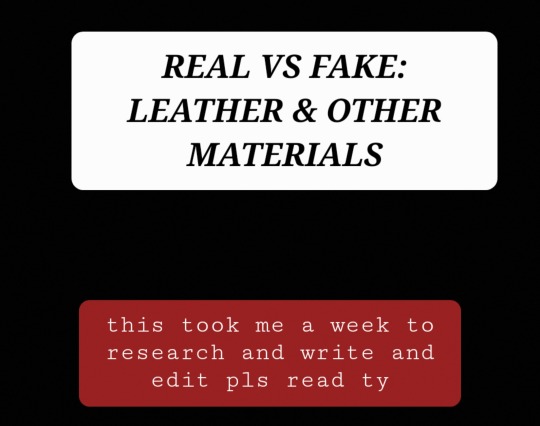
So most things are technically biodegradable at some point, except for some stuff like polyester (PET, most commonly used) which can take up to hundreds of years to degrade. which can technically be considered biodegradable but compared to chromium tanned leather (most common process), it isnt.
polyester is nearly half of all material used for clothes in general, and most when looking at synthetic materials for clothing (which also includes rayon which is semi-synthetic, and polyurethane which is synthetic).
there are different types of polyester but generally, polyethylene terephthalate is most common which is one of the most common microplastics also.
polyurathane on the other hand, which is what most fake leather is made from (usually painted over polyester, rayon, or cotton), is not toxic and biodegrades in 20-30 years. Vinyl is also used and is not biodegradable and can be toxic for the enviroment.
and rayon biodegrades even faster at a few weeks, which is another commonly used fabric.
Now these all have some sort of toxic chemical added to them whether it be polyester, rayon, or polyurethane (which is usually painted on polyester, rayon, or cotton).
so saying something is biodegradable doesnt mean anything in terms of environmental impact or even longivity. All it means is that it eventually breaks down naturally. What it also doesnt mean is that that break down is always free from chemicals bleeding into the enviroment.
Because thats what happens. You have the people who work with the chemicals to make the fabric, and then you have the fabric leaking its chemicals into wherever its left to degrade.
anyway, the most common way of tanning leather is with chrome which poisons people, the water, the land, and air.
the most common clothing material overall is polyester and cotton
for most common material used in faux leather, it would be polyurathane, which is again, painted on polyester, rayon, or cotton.
polyurathane clothing can last 30 to 100s of years depending on how its manufactured, while current chromium tanned leather lasts up to 50 years or longer, and polyester can last hundreds of years, and cotton/ rayon last years.
Leather of which is more expensive than polyurathane. So with this comparison, Leather lasts longer (with proper care) but is more toxic and more expensive, Polyurethane Leather usually has a shorter life span, but is not toxic and is less expensive.
When in comparison to all clothing, Polyester is most common, toxic, and isnt biodegradable.
Just over 1% of people are vegan (original coined Vegan Society definition);
8 million vs nearly 8 billion people.
Most vegans make under 30k and thus are low income and cant afford real leather anyway unless it was at a thrift store.
The average person is working class and probably low income and though i have no data, id say that most people arent buying genuine leather products often, because its too expensive.
So you have chrome tanned leather which is the most common type of leather bought (around 90% of all genuine leather),
and polyurethane used in fabrics which takes up only 18% of the overall uses of polyurethane, the rest is in furniture and foam for thermal insulation.
You have the most common fabric overall is polyester and cotton,
and you have approximately 8 million vegans world wide, compared to the rest of 8 billion people who arent vegan
The conclusion of all of this is:
There is no ethical consumption under capitalism
Those of us that have less money cant afford premium stuff, and when we do we want it to last
But most of the time there is a choice when shopping anywhere that isnt a thrift store.
To know that the leather you buy (unless brain/vegetable/etc tanned) is destructive inherently to the people who process it, who slaughter the animal, and the toxins it releases
and to know that there are alternatives that are less destructive- that dont even have to always be polyurathane either
to know that we all have something in our closet that involves polyester
To know all this now, not only should you take these into consideration when shopping (when youre able ofc) but to stop spreading the misinformation that "vegan" leather is worse that real leather
because vegan leather doesnt describe anything other than it doesnt come from an animal. And genuine leather doesnt even tell you how its tanned
We are not going to be the main ones buying fake leather of any kind. Just by the fact that there are more non vegans than vegans
This post is neutral, but also has an agenda. That agenda is to lay it all out so that people can see that everything has its pros and cons, but ultimately there is going to be a better choice
and the better choice isnt even "vegan" leather as a whole. If youre shopping for "vegan" leather, try and go for the more sustainable kinds of material
this post took me a week to research and write up. Id provide the graphs and sources but this is already so long, so if anyone wants to add to this and add sources please do that.
#leather#vegan#vegan ref#veganism#vegans#clothing#fr i cant prove i did the research but i didnt want to had a fuck ton of graphs and links on mobile#so pls someone do that#for me#lol ty#criessss
17 notes
·
View notes
Text
Direct Dyes vs. Reactive Dyes: Which is Right for You?

When selecting the ideal dye for your textile needs, understanding the key differences between direct and reactive dyes is crucial. Each type of dye serves distinct purposes and has its own set of benefits and limitations, making it suitable for different materials and applications.
Understanding Direct Dyes: Properties and Practical Applications
Direct dyes, a class of dyestuffs that are characterized by their water solubility and straightforward application process, are primarily used for coloring cellulose fibers like cotton, rayon, and paper. Their molecular structure allows them to adhere to the fabric through hydrogen bonding and electrostatic attraction, simplifying the dyeing procedure without the need for a mordant.
Properties of Direct Dyes:
Solubility: These dyes dissolve readily in water, facilitating a uniform distribution of color.
Affinity: Direct dyes exhibit a high affinity for cellulosic fibers, ensuring that the dye penetrates deeply and evenly.
Color Brilliance: While they provide vibrant colors initially, their susceptibility to fading under light and during washing is a notable drawback.
Cost-Effectiveness: Generally less expensive than other types of dyes, making them a popular choice for large-scale textile applications.
Practical Applications:
Textile Industry: Used extensively in the textile industry for coloring fabrics that are less subject to rigorous washing conditions.
Paper Goods: Ideal for dyeing disposable paper products such as napkins, paper towels, and packaging materials.
Leather Dyeing: Also used in the leather industry, although care must be taken due to the potential for color bleeding in wet conditions.
Things to consider: Choosing direct dyes for your manufacturing process involves balancing cost, application ease, and product requirements. They are particularly suitable for products where high color fastness is not critical, but economical production is essential.
Understanding Reactive Dyes: Properties and Practical Applications
Reactive dyes are favored for their excellent color fastness and vivid color output. They chemically bond with fibers, forming a covalent bond that is much more resistant to washing and light exposure. This makes them particularly suitable for high-quality textiles where longevity and color vibrancy are crucial.
Properties of Reactive Dyes:
Chemical Bonding: Forms strong covalent bonds with the fiber, significantly enhancing wash and light fastness.
Wide Color Spectrum: Capable of producing a wide range of bright and deep colors, reactive dyes are versatile in their application.
Solubility and Application: Soluble in water, these dyes require a controlled alkaline environment for application, necessitating precise handling during the dyeing process.
Practical Applications:
Fashion and Apparel: Ideal for clothing that demands high durability and color richness, such as sportswear and outdoor apparel.
Home Textiles: Used in home textiles like towels and bed linens that frequently undergo hot wash cycles.
Art and Craft: Increasingly popular in artisanal crafts for achieving vibrant and lasting colors on natural fibers.
Tips for Application:
Pre-treatment: Ensure that the textile is thoroughly prepared and free from impurities to maximize dye uptake.
Temperature and pH Control: Adhere to the specific temperature and pH requirements during the dyeing process to ensure optimal color fixation.
Aftercare: Post-dyeing washes are necessary to remove any unreacted dye, which if not properly washed out, can lead to poor colorfastness.
By integrating these advanced dyes into your processes, you can significantly enhance the appeal and value of your textile products. Reactive dyes provide a robust solution for industries aiming for superior quality and durability in dyed materials.
Advantages and Disadvantages of Dyes
Advantages of Direct Dyes: Cost-effectiveness, ease of application, and ability to produce vibrant colors are the major advantages. They are commonly used for non-critical consumer goods, including some fashion accessories and home textiles .
Disadvantages of Direct Dyes: The main drawback is their poor wash and light fastness, which can lead to rapid color degradation under normal use conditions.
Advantages of Reactive Dyes: Known for their color permanency and excellent fastness properties, reactive dyes are preferred for high-quality textiles that require long-lasting color vibrancy.
Disadvantages of Reactive Dyes: They can be more complex to apply correctly and might require more rigorous post-dyeing washes to remove unreacted dye, which could increase the process cost and environmental impact.
Visit Meghmani Global for more information about Dyes and Textiles
#reactive dyes#crop protection chemicals#pharmaceutical packaging manufacturer#reactive dyes manufacturers#direct dyes manufacturers#direct dyes#acid dyes#pharmaceutical packaging industry#solvent dye suppliers in gujarat#optical brightening agents
0 notes
Text
Rayon or Cotton: Which is the Better Fabric for Clothing
It totally depends on fibre fabric when it comes to selecting fabric for clothing, both rayon and cotton have distinct advantages and characteristics that cater to different needs and preferences. The properties, benefits, and potential drawbacks of each fabric can help you make an informed decision about which is better suited for our specific clothing requirements.

Cotton: The Natural Choice
1. Origin and Production
Pure linen fabric as cotton is a natural fibre harvested from the cotton plant. It has been used for thousands of years and is known for its comfort, breathability, and versatility. The production process involves picking the cotton, cleaning it to remove seeds, and spinning it into yarn, which is then woven or knitted into fabric.
2. Comfort and Breathability
Cotton is renowned for its softness and breathability. It allows air to circulate freely, making it an excellent choice for warm weather and everyday wear. The natural fibers are gentle on the skin, reducing the likelihood of irritation and allergies.
3. Durability
Cotton fabrics are generally durable and can withstand frequent washing and wear. High-quality cotton garments can last for many years, making them a worthwhile investment. However, cotton can shrink when washed in hot water, so it's important to follow care instructions.
4. Absorbency
Cotton is highly absorbent, which is beneficial for sweat absorption and maintaining comfort in hot climates. However, this property also means that cotton can become heavy and take longer to dry when wet.
5. Environmental Impact
Conventional cotton farming requires significant water and pesticide use, which can have environmental implications. However, organic cotton is grown without synthetic pesticides and fertilizers, making it a more sustainable option.
6. Applications
Cotton is incredibly versatile and is used in a wide range of clothing items, from T-shirts and jeans to underwear and bed linens. Its natural properties make it suitable for both casual and formal wear.
Rayon: The Semi-Synthetic Alternative
1. Origin and Production
Rayon is a semi-synthetic fiber made from cellulose, typically derived from wood pulp. It was developed as a cheaper alternative to silk and mimics the feel and drape of natural fibers. The production process involves dissolving cellulose in chemicals and then extruding it into fibers.
2. Softness and Drape
Rayon is prized for its luxurious softness and excellent drape, making it ideal for garments that require a fluid silhouette. It feels smooth against the skin and adds an element of elegance to clothing.
3. Breathability and Comfort
Rayon is breathable and comfortable to wear, although not as breathable as cotton. It is suitable for warm weather but may not perform as well as cotton in extremely hot conditions.
4. Moisture Absorbency
Rayon is moderately absorbent and dries faster than cotton. This makes it a good choice for activewear and summer clothing, as it can wick moisture away from the body more efficiently.
5. Care and Maintenance
Rayon requires more delicate care compared to cotton. It can weaken when wet and may shrink or lose its shape if washed in hot water or dried at high temperatures. Hand washing or using the gentle cycle on a washing machine and air drying is recommended.
6. Environmental Impact
The production of rayon involves significant chemical processing, which can have environmental impacts. However, newer methods like Lyocell (a type of rayon) use more eco-friendly processes and are biodegradable, offering a more sustainable option.
7. Applications
Rayon is often used in clothing that requires a soft, flowing drape, such as dresses, blouses, and skirts. Its ability to mimic the feel of silk and other luxurious fabrics makes it a popular choice for evening wear and formal attire.
Comparison: Rayon vs. Cotton
1. Comfort
Cotton: Offers superior comfort due to its softness, breathability, and hypoallergenic properties. Ideal for everyday casual wear and activewear.

Rayon: Provides a luxurious feel and excellent drape, making it perfect for dressier garments and evening wear. Comfortable but may not be as breathable as cotton.
2. Durability
Cotton: Generally more durable and can withstand frequent washing and wear. High-quality cotton garments can last for many years.
Rayon: Requires more delicate care and is prone to weakening when wet. Not as durable as cotton but can be long-lasting if properly maintained.
3. Care and Maintenance
Cotton: Easier to care for, with most garments being machine washable and dryer-friendly. Care must be taken to avoid shrinking.
Rayon: Requires delicate handling, including hand washing or using the gentle cycle on a washing machine and air drying. More susceptible to damage from high temperatures.
4. Environmental Considerations
Cotton: Organic cotton is a sustainable option, but conventional cotton farming has significant environmental impacts due to water and pesticide use.
Rayon: The production process involves chemicals, but newer eco-friendly methods like Lyocell offer a more sustainable alternative. Generally less sustainable than organic cotton.
5. Applications
Cotton: Suitable for a wide range of clothing items, from casual to formal wear. Ideal for everyday garments like T-shirts, jeans, and underwear.
Rayon: Best for garments that require a soft, flowing drape, such as dresses, blouses, and evening wear. Mimics the feel of luxurious fabrics like silk.

1 note
·
View note
Text
0 notes
Text
Embroidery A Deep Dive into Bobbins
The Unsung Hero of Embroidery: A Deep Dive into Bobbins
Embroidery machines are marvels of precision and creativity, transforming thread into stunning designs. But behind the dazzling needlework lies a silent partner, a workhorse that ensures smooth stitching – the bobbin. Often overlooked, the bobbin plays a crucial role in creating beautiful embroidery. This comprehensive guide delves into the world of embroidery machine bobbins, exploring their types, uses, and how to get the most out of them.
Bobbin Basics: Size Does Matter
Embroidery machine bobbins come in various sizes, designated by letters or numbers. The most common are:
Class 15 (A Style): This is the standard size for most home embroidery machines.
Style L: Often found in commercial embroidery machines, these offer a larger capacity for longer stitching times.
Style M: Another commercial bobbin size, slightly smaller than Style L.
Choosing the Right Bobbin: Always refer to your embroidery machine's manual for the recommended bobbin size. Using an incorrect size can cause tension issues, thread breakage, and uneven stitching. Some machines may even have sensors that detect the bobbin size and prevent use with incompatible ones.
Bobbin Materials: Plastic vs. Metal
Plastic Bobbins:
Pros: Lightweight, inexpensive, readily available pre-wound.
Cons: Not as durable as metal, can melt at high sewing speeds, some may not wind thread evenly.
Metal Bobbins:
Pros: Durable, withstand high sewing speeds, provide smoother thread tension.
Cons: Heavier than plastic, can be more expensive.
The ideal choice depends on your embroidery needs. Plastic is convenient for small projects, while metal may be preferable for heavy-duty embroidery or high-speed machines.
Pre-wound vs. Self-wound Bobbins
Pre-wound Bobbins:
Pros: Convenient, time-saving, available in various thread colors.
Cons: Often more expensive than winding your own, limited thread variety.
Self-wound Bobbins:
Pros: Cost-effective, allows for using any thread color or type, greater control over thread tension.
Cons: Takes time and practice to wind evenly, requires compatible bobbin winder.
For beginners, pre-wound bobbins offer a convenient way to get started. Experienced embroiderers may prefer the flexibility and cost-savings of self-winding.
Thread Selection: The Perfect Match for Your Bobbin
While the top thread in embroidery gets most of the attention, the bobbin thread plays a vital role. It's crucial to choose the right type for optimal results:
Match Thread Weight: Use thread with a similar weight to the top thread. A lighter weight bobbin thread can cause puckering, while a heavier weight can create tension issues.
Consider Thread Type: Use rayon or polyester thread for bobbins, as they offer smooth feeding and minimal lint. Cotton thread, commonly used for top threads, can cause friction in the bobbin case.
Color Coordination: For opaque fabrics, use a bobbin thread that matches the top thread color for a seamless look. For sheer fabrics, use a clear or neutral bobbin thread.
Bobbin Winding Tips: Winding for Success
Choosing to self-wind bobbins requires mastering the technique. Here are some tips to ensure even and tension-controlled bobbins:
Use a Compatible Bobbin Winder: Most sewing machine dealers offer bobbin winders specifically designed for your machine model.
Thread Tension: Set the tension on the bobbin winder slightly looser than the top thread tension. This allows the bobbin thread to unwind smoothly during stitching.
Winding Technique: Maintain a steady hold on the thread spool as the bobbin winds. Avoid overfilling the bobbin, as this can cause tension issues.
Bonus Tip: For added security, place a small piece of thread leader tape at the beginning of the wound thread. This prevents the thread from unraveling when the bobbin is inserted into the machine.
Bobbin Care: Keeping Your Workhorse in Top Shape
Proper bobbin care ensures smooth operation and prevents stitching problems. Here's how to maintain your bobbins:
Store Properly: Keep bobbins in a cool, dry place away from direct sunlight. Dust and dirt can affect thread flow.
Clean Regularly: Wipe down metal bobbins with a soft cloth to remove any dirt or lubricant residue.
Inspect for Damage: Check for nicks, cracks, or warping on your bobbins before each use. Discard any damaged bobbins to avoid thread breakage and tension issues.
By following these simple tips, you can extend the life of your bobbins and ensure flawless embroidery results.
Troubleshooting Common Bobbin Problems: Stitching Success One Fix at a Time
Even with the best care, bobbin issues can arise during embroidery. Here's a breakdown of common problems and solutions to get your machine stitching smoothly again:
Problem 1: Uneven or Looped Stitches
Cause: The most likely culprit is incorrect bobbin thread tension.
Solution:
Check your machine's manual for proper bobbin tension settings.
If the tension feels loose, gently tighten the bobbin case screw (usually a small screw on the bobbin case itself) by a quarter turn at a time, re-testing the tension after each adjustment.
Avoid over-tightening, as this can cause thread breakage.
Problem 2: Birdnesting (Thread Tangling Underneath the Fabric)
Cause: This can occur due to various factors, including:
Incorrect bobbin threading: Ensure the thread is properly routed through the bobbin case tension disc.
Loose bobbin tension: As mentioned earlier, a loose bobbin thread can cause loops to form underneath the fabric, leading to birdnesting.
Damaged bobbin case: Nicks or burrs on the bobbin case can snag the thread, causing tangles.
Solution:
Double-check your bobbin threading technique. Refer to your machine's manual for specific instructions.
Adjust the bobbin tension as needed.
Inspect the bobbin case for any damage. If damaged, replace it with a new one.
Problem 3: Thread Breakage
Cause: Several factors can contribute to thread breakage:
Incorrect bobbin thread type: Using thread not designed for bobbins (like cotton) can cause friction and breakage.
Overfilled bobbin: Too much thread on the bobbin can create excessive tension, leading to breakage.
Damaged bobbin: Nicks or rough edges on the bobbin can snag and break the thread.
Solution:
Use the appropriate thread type for bobbins, such as rayon or polyester.
Avoid overfilling the bobbin. Wind only until the thread reaches the top of the bobbin.
Inspect your bobbins for any damage and replace them if necessary.
Problem 4: Bobbin Case Not Seated Properly
Cause: If the bobbin case isn't inserted correctly, it can cause the machine to malfunction and prevent proper stitch formation.
Solution:
Refer to your machine's manual for specific instructions on inserting the bobbin case.
Ensure the bobbin case clicks securely into place.
Problem 5: Unusual Noises
Cause: Grinding or scraping noises can indicate a damaged bobbin case or a foreign object lodged in the bobbin area.
Solution:
Turn off the machine and unplug it.
Carefully remove the bobbin case and inspect it for any damage.
Check the bobbin area for any debris or loose threads that might be causing the noise.
If the noise persists after cleaning, consult your machine's manual or a qualified technician.
Bonus Tip: Always maintain a clean embroidery machine. Regularly remove dust and lint from the bobbin area to prevent thread buildup and potential issues.
By understanding these common bobbin problems and their solutions, you can effectively troubleshoot your embroidery machine and achieve beautiful, professional-looking results.
In the final section of this blog post, we'll explore some advanced bobbin techniques and explore how to get the most out of your embroidery machine's bobbin capabilities.
Read the full article
0 notes
Text
Cotton Vs. Synthetic Fabrics: A Comparative Analysis of Laundry Care

Cotton Laundry
Laundry Care involves washing many fabrics depending upon the textures, colour and nature of garments. Each cotton cloth is like the shades of a rainbow, with each fabric differing from the other. For example within the category of cotton clothes comes 100% cotton, blended cotton such as polyester, rayon or silk, heavy cotton used in denim, towels etc. Similarly, synthetic fabrics include innumerable materials. It includes polyester, rayon and nylon. These categories are made for our brief understanding and are very major broad divisions. Despite this division between the two kinds of fabric, there are overlaps between them,. For example, cotton is often blended with synthetic fabrics. Laundry care involves washing each kind of garment according to their optimum care. The instructions labels for washing on the clothing can be of help. The expertise of professional laundry Kolkata can best determine the most proper and appropriate way to handle, wash and clean your garments.
Cotton vs Synthetic Fabrics
Let us first begin to unwrap what are cotton and synthetic fabrics. Cotton is the natural fibre derived from cotton plants whereas synthetic fabrics are artificial or man-made fabrics. Synthetic fabrics usually include rayon, polyester, spandex and acrylic. Synthetic yarns are processed from chemical synthesis, therefore they are called synthetic fabrics.
Some of the essential features of synthetic fabrics are -:
They are durable and resistant to losing shape and causing creases or wrinkles.
They are water resistant, causing less sweat absorption
Synthetic fabrics are highly versatile making them ideal for sportswear and other athletic wear
Affordable- synthetic fabrics are cheaply available. For example, rayon is a synthetic fabric made to look like silk.
Some of the essential features of cotton fabrics are -:
They are highly absorbent
They are less durable and more prone to losing shape and causing wrinkles or shrinkage.
They are biodegradable and do not clog natural ways.
A Comparative Analysis of Laundry Care
Sorting
Laundry Kolkata follows certain steps in washing different kinds of synthetic or cotton laundry. The first step remains the same in cotton as well as synthetic fabrics. It involved sorting of the garments by laundry Kolkata inspecting stains and pre-treating them. Sorting also involves differentiating coloured from non coloured ones thus preventing colour fading or drainage.
Washing
Specific kinds of natural fibres are very delicate. They require a dry cleaning service to maintain their crispy and new-like appearance. The rigorous stretching of the fabrics with high heat temperatures can cause shrinkage and damage to the fabric. Most people recommend washing cotton laundry at high temperatures and high-speed spin cycles. However, home treatment of these natural fibres can be very harmful. They lead to shrinkage, discolouration and wrinkage. Due to its water absorbent capacity, high-speed spin cycles are required to process the churning and removal of water from cotton laundry. The removal of stains, grime and dirt from cotton fabrics requires more vigorous processing and washing than synthetic fabrics. Blended cotton, on the other hand, for example, poly or rayon blend cotton is more durable and less prone to wrinkles. One can safely get them their mild spin cycle. Your garmets must be cleaned effectively and stains removed. Often the concern over the natural fabric overlooks the cleanliness of the garments. Laundry service kolkata can wash in several ways that help protect your fabric as well as effectively clean it. Synthetic garments are easier to process due to their great durability. They are long-lasting and less resistant to the change in the shape and texture of the garments. Synthetic garments do not require a vigorous spin cycle. They can easily be cleaned with mild detergents and delicate spin cycles. Synthetic fabrics such as Rayon cannot withstand more heat as it can lead to melting and ripping
Drying
Drying is a crucial process in laundry Kolkata. Cotton is made with greater absorbency of water. Often high temperature is used to stream dry these kinds of fabrics by laundry Kolkata, however, it is important to bear in mind that high temperature can be harmful to these fabrics. They should either be dried by hanging them or placing them on a rack. Placing of cotton laundry in the rack is the better method followed by laundry Kolkata to keep your cherished cotton wear in good shape. Drying synthetic fabrics is much easier as they do not absorb much water and only a mild cycle is enough to make them dry. It is recommended not to keep your cotton or synthetic fabric directly under the sun as it can lead to colour fading.
Ironing
The ironing process of cotton and synthetic fabric also differs. Synthetic fabrics such as nylon require the lowest temperature. Cotton laundry requires a more higher temperature than other synthetic garments such as polyester and silk. laundry and dry cleaning kolkata takes caution not to cause burn holes or burning to your clothes. They use the commercial steam iron to redress your wrinkles and creases and make sure your clothes look presentable and appropriate.
Laundry and dry cleaning services in Kolkata are several. One of the best recommended is SpinCare Laundry service which addresses your fabric concern most effectively giving the natural fabric the protection and care it needs as well as being careful of the synthetic fabrics, keeping them cleaned and fresh.
0 notes
Text
Rayon vs Cotton
Rayon is produced using processed plant fibers. It is often considered an artificial material and is more affordable than cotton. Because of its processed origin, it tends to be fairly durable and can often be found in clothing that also includes other synthetic fibers..Cotton, on the other hand, is a natural material, produced directly from plant fibers and is therefore much more breathable than rayon. It is often a bit more expensive than rayon but overall it is viewed as a more "luxurious" material.
0 notes
Text
Rayon vs Cotton
Rayon is produced using processed plant fibers. It is often considered an artificial material and is more affordable than cotton. Because of its processed origin, it tends to be fairly durable and can often be found in clothing that also includes other synthetic fibers..Cotton, on the other hand, is a natural material, produced directly from plant fibers and is therefore much more breathable than rayon. It is often a bit more expensive than rayon but overall it is viewed as a more "luxurious" material.
0 notes
Text
Rayon Vs Cotton
Rayon is derived from treated plant fibers, typically regarded as a synthetic substance and priced more economically compared to cotton. Due to its processed nature, it generally exhibits decent durability and is commonly utilized in garments blended with other synthetic fibers. Conversely, cotton is a natural fabric sourced directly from plant fibers, offering superior breathability compared to rayon. While it tends to be slightly pricier than rayon, cotton is generally perceived as a more upscale material.
0 notes
Text
A Strategic Guide to Launching Your Profitable T-shirt Business in India

In an era saturated with mainstream fashion, the pursuit of personal style drives countless individuals to seek out distinctive forms of self-expression. Crafting your own T-shirts presents a remarkable chance to showcase your individuality, and at Stitch Perfect, we enhance this journey by providing custom printed T-shirt designs that perfectly reflect your unique identity.
Embarking on the journey of a profitable t-shirt business in India requires a blend of strategy, market understanding, and a keen eye for opportunities. Here’s your comprehensive guide to navigate the nuances of this dynamic industry.
Starting Strong: The Blueprint for Success
Starting a t-shirt business demands time, effort, and resources, with profitability emerging as the ultimate goal. However, success lies in understanding the unique dynamics of the Indian market. Limited collections may not sustain a new brand; however, a broader product category is recommended to maximize the impact of advertising efforts.
Market Dynamics: Beyond the Fantasy
In India, market dynamics differ significantly from Western countries. A tailored approach is crucial. Before diving in, thorough research on market preferences and trends is imperative.
If you are looking for a t shirt manufacturer in India than contact us at +919167394967.
Product Obsession vs. Profit Focus
While product passion is essential, the focus should shift to creating items that sell in large volumes. Profitability is the key from day one, allowing for sustainable business growth and brand development.
Investments & Online Presence: Building Your Brand
Starting an online store opens doors to a myriad of opportunities. Greed, when channeled positively, becomes a powerful business tool. Capitalize on the online T-shirt market with strategic investments and a clear vision of future trends.
Storming the Market with an Inventory Model
Printed t-shirts dominate the market, but there’s untapped potential in exploring diverse fabric compositions. Opt for the Inventory Model, setting prices at 4X cost-price for a profitable venture. Professional product photography becomes a crucial investment.
We Stitch perfect are a T-shirt supplier with affordable rates.
Trending Styles and Fabrics
Understanding market trends is paramount. Unisex round neck and full sleeve tees, oversized tees, polo shirts, and sweatshirts are currently in vogue. Diversify with fabric compositions like combed cotton, Pima cotton, bamboo cotton, rayon/viscose, organic cotton, and cotton-polyester blends.
Quality Matters: Basics of T-shirt Quality
To ensure customer satisfaction, address issues like shrinkage, color fastness, print durability, linting, and accurate measurements. Quality assurance forms the foundation of a successful t-shirt business.
Conclusion: Paving the Path to Profitable Heights
Transitioning from a budding venture to a profitable printed t-shirt business requires a strategic blend of product appeal, market understanding, and a profit-centric mindset. Navigate the challenges, stay abreast of trends, and watch your t-shirt business flourish in the diverse and dynamic Indian market.
For more details visit our website https://stitchperfect.co.in
1 note
·
View note
Text
THE 5 DIFFERENT TYPES OF FABRIC

Knowing the fabric's characteristics is crucial if you're making fresh clothes or simply trying to find the most effective method of cleaning your old ones. This is particularly true in the case of a lovely piece of fabric, and you wish to take proper care of it so it will last longer. Different materials possess different characteristics, which can significantly affect how you handle your clothing. For instance, one fabric's fiber content can affect how you clean your garment differently from another material's fiber content.
To ease some of the confusion and help to understand what fabric is, Let's look at five different types of materials. Remember that there are many different kinds of fabrics; this article will only focus on the five most popular types.
Also Read Melange Fabric Meaning
The Different Types of Fabric
In the beginning, "fabric" is a substance made by connecting fibers. Generally, a fabric is named in honor of the yarn used for production. Some fabrics may even make use of a blend of various fibers. The fabric is called in accordance with the thread (s) employed along with its texture, pattern, and process of production used. Certain fabrics also look at the origin of the fibers.
In this regard, two distinct classifications first distinguish the fabrics used: the types of fibers (natural and synthetic). synthetic) and the manufacturing processes (woven and knitted. knitting).
Natural and Synthetic
The primary difference between fabrics is the kind of fiber utilized. There are two kinds: synthetic and natural.
Natural fibres come from animals and plants. For instance, cotton comes from plants, whereas silk comes from silkworms.
Synthetic fibers, on the contrary, are entirely from synthetic material made by humans.
Woven fabric
Woven vs. Knitted
Another difference is the manufacturing process employed. There are two kinds: knitted and knitted.
Woven fabrics consist of two yarn pieces which are interwoven vertically and horizontally on the weaver. Because the yarn runs at a 45-degree angle, the fabric won't stretch and tends to be tauter and stronger than knit fabrics. The material comprises two parts: a warp (when the yarn is stretched across the entire width of fabric) and the warp (when the thread runs along the length of the loom).
There are three kinds of weaved fabric, including plain weave, satin weave, and Twill weave. Some popular weaves are crepe, chiffon denim linen, satin, and silk.
When you think of knit fabric, imagine hand-knit scars; the yarn is shaped to form an interlocking loop which allows it to stretch considerably. Knit fabrics are renowned for their elastic properties and for maintaining their shape.
There are two kinds of knit fabric: warp knitted and weft knitted. The most well-known knit fabric is lace mesh and lycra.
Now, let's take a look at the different kinds of fabrics.
Chiffon fabric
1. Chiffon
Chiffon is a fine simple, lightweight fabric made of twisty yarn, which has a rough feeling. The thread is generally comprised of nylon, silk rayon, polyester or.
Chiffon is a dye-able fabric that can be easily dyed and is typically used in blouses, scarves and dresses, which include prom dresses and wedding dresses because of its lightweight, flowing fabric.
Cotton fabric
2. Cotton
The most sought-after fabric in the world, cotton fabric, is a soft, light natural material. The soft fibre is extracted by removing the cotton plant's seed during the spinning process. The thread is transformed into cloth, and it is knit or weaved.
This fabric is widely praised for its comfort, flexibility and strength. It's hypoallergenic and breaths well, but it cannot dry quickly. Cotton is present in nearly every type of clothing: shirts, dresses, underwear, and more. But, it is prone to be prone to shrinking and wrinkles.
Cotton produces a variety of other fabrics, such as gingham, chintz, chino and Mullin.
Crepe fabric
3. Crepe
Crepe is a light, plain-woven material that is twisted and has rough, bumpy surfaces that aren't wrinkled. It's typically made of wool, silk, cotton, and synthetic fibres, making it a flexible fabric. Because of this, crepe is generally referred to by its thread. For instance, crepe silk or chiffon.
Crepe is commonly employed in dressmaking and suits because it's soft, comfy, and straightforward. For instance, georgette is a crepe fabric widely used in designer clothing. Crepe can also be found in pants, blouses, scarves, shirts, and skirts.
Denim fabric
4. Denim
Another kind of material is called denim. Denim is a woven cotton twill material constructed from interspersed cotton wrap yarn and white stuffing yarn made of cotton. Denim is often praised for its vibrant texture, toughness, and ease of use.
Denim is dyed mostly in indigo to create blue jeans. However, it can also be used to dye clothes and jackets.
Lace fabric
5. Lace
Lace is a beautiful delicate fabric made of looped, twisted or knitted thread or yarn. It was initially made of linen and silk, but the lace fabric is now made of wool, cotton thread and synthetic fibers. Lace has two significant components: the pattern and the material that binds the design.
Lace is a luxurious fabric requiring time and experience to make open-weave and web-like patterns. The soft, translucent material is frequently utilized to enhance or complement clothing, especially wedding gowns and veils, but it can also be found in dresses and shirts.
0 notes